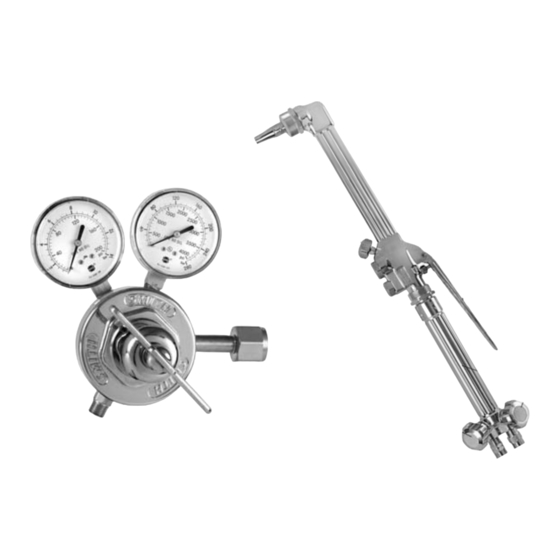Miller OM-262 659C Panduan Keselamatan - Halaman 6
Jelajahi secara online atau unduh pdf Panduan Keselamatan untuk Sistem Pengelasan Miller OM-262 659C. Miller OM-262 659C 46 halaman.

D
It is recommended that a reverse-flow check valve or a flashback ar-
restor be installed between the torch handle and the regulator. Check
valves do not prevent the propagation of a flame upstream (flash-
back) but are designed to prevent the unintentional backflow of gases
into the cutting attachment, torch, hoses, or regulator which could
cause an explosion or fire. A flashback arrestor can be installed on the
torch handle instead of a check valve. Miller flashback arrestors have
a reverse flow check valve and prevent the propagation of a flame up-
stream. If a flashback arrestor is installed, a check valve is not neces-
sary. Using a flashback arrestor and a check valve may reduce gas
flow and affect torch operation. To help prevent the reverse flow of
gases, be sure the cylinders contain enough gas to complete the
work.
D
Perform work only in an area with a fireproof floor (concrete). Do
not heat concrete because it may expand and explode violently.
D
Perform work on a fireproof surface. Use heat resistant shields to
protect nearby walls and flooring.
D
Do not use if grease or oil is present on equipment or if equipment is
damaged. Have equipment cleaned/repaired by a qualified per-
son.
D
Do not open a cylinder valve quickly or the regulator may be dam-
aged and cause a fire.
D
Do not open acetylene cylinder valve more than 3/4 turn. (For all
gases except acetylene, open cylinder valve fully to backseal the
cylinder valve.) Keep cylinder wrench on the cylinder for quick
shut-off.
D
Do not slightly open or "crack" fuel cylinder valve to blow debris
from the valve outlet. Remove the debris using nitrogen, air, or a
clean, oil-free rag.
D
Always purge gas from the system before lighting torch. Purge gas
in a well-ventilated area and away from flame or sparks.
D
Keep torch flame or sparks away from cylinder, regulator, and gas
hose.
D
Use only the gases recommended by the manufacturer of the
oxy-fuel equipment being used.
D
Never light a torch with matches or a lighter. Always use a striker.
D
Do not use acetylene above 15 psi (103 kPa) flowing. It is accept-
able to use acetylene regulators that indicate a static pressure up
to 22 psi (151 kPa).
D
Check oxy-fuel system for leaks with an approved leak detection
solution or leak detector. Never test for gas leaks with a flame.
D
Remove all flammables within 35 ft (10.7 m) of the welding or cut-
ting operation. If this is not possible, tightly cover them with ap-
proved covers.
D
Do not weld or cut where flying sparks can strike flammable
material.
D
Protect yourself and others from flying sparks and hot metal.
D
Be alert that welding and cutting sparks and hot materials from
welding and cutting can easily go through small cracks and open-
ings to adjacent areas.
D
Watch for fire, and keep a fire extinguisher nearby.
D
Be aware that welding or cutting on a ceiling, floor, bulkhead, or
partition can cause fire on the hidden side.
D
Do not weld or cut on containers that have held combustibles, or on
closed containers such as tanks, drums, or pipes unless they are
properly prepared according to AWS F4.1 and AWS A6.0 (see
Safety Standards).
D
Do not weld or cut where the atmosphere may contain flammable
dust, gas, or liquid vapors (such as gasoline).
OM-262 659 Page 4
